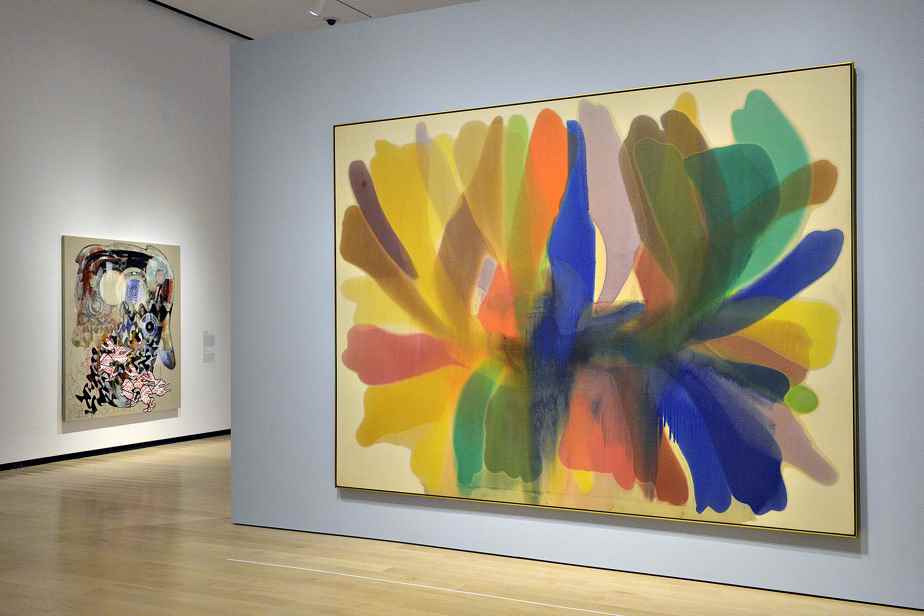The Musée national des beaux-arts du Québec is offering an exhibition this summer featuring 96 works from the Hirshhorn Museum in Washington. America. Between dreams and realities includes paintings, sculptures, works on paper and videos created in the XXe and XXIe centuries by 82 American artists. A pictorial and historical journey of these unfinished United States, between American dream and daily dramas.
Posted at 7:16 a.m.
America is both a look at American art and a partial incursion into the heart of the collection compiled by Joseph Herman Hirshhorn (1899-1981). This collection ended up in 1974 at the Smithsonian Institution in Washington, in a museum that bears the name of the businessman of Latvian origin.
It is also and above all an introspection of the United States, its social history and the demons that still haunt the democracy established by Thomas Jefferson and his peers in 1776.

PHOTO PATRICE LAROCHE, THE SUN
To the left, Target Practice (1968), by Peter Saul (1934 —), and on the right, General Nuke (1984), by Robert Arneson (1930-1992)
From the beginning of the visit, we begin… with the end! Consider American society as we know it today through the media, that is to say the challenges inherent in its diversity. Artists Hank Willis Thomas, Eric Gottesman and Emily Shur, from the For Freedoms collective, put their finger on the bobo by reusing the work Four Freedoms produced in 1943 by illustrator Norman Rockwell following a speech by President Roosevelt.
These four post-war freedoms become more inclusive with For Freedoms, which took into account today’s ethnic and religious diversity.

PHOTO PATRICE LAROCHE, THE SUN
freedom of worshipa photograph by the collective For Freedoms
The American dream of a better life, in complete freedom, is illustrated by a section of pop art works and reflections on the role of consumption. With paintings by Rosalyn Drexler, Julian Schnabel and of course Andy Warhol. The importance of the environment for American artists, and the identity links they make, also deserves a space.
With contemporary photographs by William Christenberry reminiscent of film America Baghdad Cafea very symbolic acrylic by Malcolm Morley, beach sceneor the Point of Tranquility of Louis Morris and the very abstract Delaware Gap by Franz Klein.

PHOTO PATRICE LAROCHE, THE SUN
Chubby Checker1964, Rosalyn Drexler, oil, acrylic and photomechanical reproductions on canvas, 190.3 x 165.6 cm
Works bring back memories, because we have seen them on other occasions, such as the interior scene Hotel by a Railroad (1952), by Edward Hopper. Or Marilyn Monroe’s luscious lips enhanced tenfold by Andy Warhol.
Others astonish like that of Man Ray, New York 17a very interesting sculpture from 1966, echoing a work from 1917 when, when very young, he wanted to translate, in the form of a Dadaist work, the modernity and dynamism of the New York economy and society. .
-

PHOTO PATRICE LAROCHE, THE SUN
Hotel by a Railroadcirca 1952, Edward Hopper (1882-1967), oil on canvas, 79.4 x 101.9 cm
-

PHOTO PATRICE LAROCHE, THE SUN
Marilyn Monroe’s Lips1962, Andy Warhol, acrylic, silkscreen ink and graphite on canvas, panel A (left): 210.2 x 205.1 cm, panel B (right): 210.2 x 209.2 cm
1/2
Others amaze or move as The mother (1952), by Charles White, or Untitleda photograph from the series Fashion Series by Cindy Sherman on the pandemic of artificial seduction infecting the media and advertising circles, or even Love is the Message, the Message is Deaththe punchy video by Arthur Jaffa discovered at the Musée d’art contemporain de Montréal in 2020, a remarkable work in which the artist summarizes in 7 min 30 s the incredible and scandalous history lived by the African-American communities of the States -United.
-

PHOTO LEE STALSWORTH, HIRSHHORN MUSEUM, PROVIDED BY THE MNBAQ
The Mother1952, Charles White, pen and graphite drawing on paper, 77.5 x 56.6 cm
-
![If I don't, someone should, 'cause you deserve it [If I don’t, someone should as you are so deserving]2020, Henry Taylor (1958 —), acrylic on canvas, 243.8 x 304.8 cm](https://mobile-img.lpcdn.ca/v2/924x/7b849ab32abc3f279c4a5867faf331fe.jpg)
PHOTO PATRICE LAROCHE, THE SUN
If I don’t, someone should, ’cause you deserve it [If I don’t, someone should as you are so deserving]2020, Henry Taylor (1958 —), acrylic on canvas, 243.8 x 304.8 cm
1/2
We leave this exhibition rather contented, with the foreseeable feeling that the history of the United States is as fascinating as it is irritating. As illustrated by Flag (1960), by Jasper Johns, it does not lack asperities. But no poetry either, as Jim Hodges shows with his silk flowers (This Way In, 1999).
These works of the Hirshhorn ultimately underline the rich complexity of our great neighbour, a charismatic nation whose diversity is not synonymous with harmony, but which has the merit of still and always, 246 years after its foundation, being a adventure to shape, which the artists will take care of depicting. To our delight.
-

PHOTO PATRICE LAROCHE, THE SUN
PHOTO1961, Mark Rothko, oil on canvas, 229.2 x 205.9 cm
-

PHOTO PATRICE LAROCHE, THE SUN
7-Up1961, Claes Oldenburg (1929 —), enamel, plaster, canvas and wire, 140.7 x 99.7 × 14 cm
-

PHOTO PATRICE LAROCHE, THE SUN
lucky lines2018, Nicole Eisenman (1965 —), oil on canvas
-

PHOTO PATRICE LAROCHE, THE SUN
Red dress1992, Beverly Semmes (1958 —), velvet and hanger, variable dimensions
1/4
The exhibition is accompanied by a 152-page catalog and 109 photographs, produced under the direction of André Gilbert, exhibition curator at the MNBAQ. The book retraces the seven sections ofAmerica.
America. Between dreams and realitiespresented until September 5.

